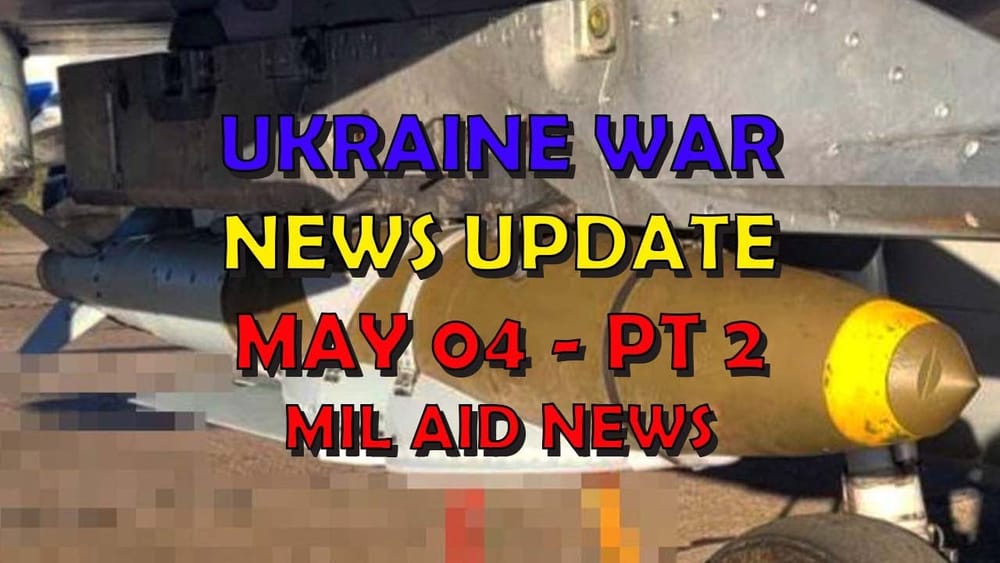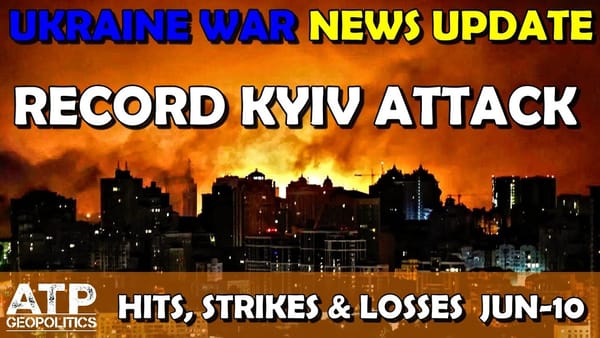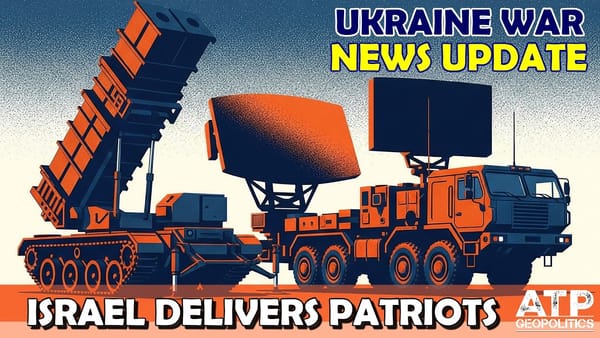Ukraine War Update NEWS: Military Aid News
Table of Contents 📖
"They [the Ukrainian soldiers training with British and Dutch troops] go and speak to their family and friends... they... spread the information about the Ukrainians hopefully correct information... doing a job for promoting the pro-Ukrainian narrative... all of these people are themselves part of the information war as well as the real war - that's what I think when I see stuff like that."
Hello Team
🎦 00:00-01:09⏩
Jonathan wishes viewers a happy Star Wars Day ("May the 4th be with you"). He mentions that he missed ANZAC day this year (which commemorates Australians and New Zealanders who served and died in war) and how his son, Oscar, loves to make ANZAC cookies - although mainly for the mixture!
Return to top⤴️
Potential $50bn Ukraine Aid Package funded by Russian Assets
🎦 01:09-03:35⏩
The US is in talks with G7 partners to create a $50bn aid package for Ukraine, financed by the profits generated from frozen Russian assets, primarily held in Europe. This initiative aims to expedite the delivery of aid to Ukraine, as the frozen assets, yielding roughly $5bn in annual profits, could potentially cover the entire package cost. The US intends to present this plan at the June G7 summit in Italy, aiming to secure a collective agreement among the G7 nations. However, finalising the agreement may take several months. Jonathan thinks this would be great timing, as it could coincide with the anticipated reduction in US aid packages later this year.
Return to top⤴️
US allocates $250m to Ukrainian Agricultural Sector
🎦 03:35-04:17⏩
The US, through USAID, has dedicated $250m to bolster Ukraine's agricultural sector. The funding will be used for rebuilding and expanding Ukraine's agricultural infrastructure. This aid is particularly crucial given the sector's significance to Ukraine's economy. Jonathan notes that the recent easing of border restrictions between Poland and Ukraine has already facilitated increased agricultural exports, demonstrating positive progress in this area.
Return to top⤴️
Germany: Zuzana 2 Howitzers destined for Ukraine delayed due to missing parts
🎦 04:17-05:10⏩
Jonathan highlights a delay in the delivery of Zuzana 2 howitzers to Ukraine. While Germany, Denmark, and Norway had financed the purchase of these self-propelled howitzers from Slovakia back in August 2023, their delivery has been stalled. The manufacturer, prioritizing howitzer deliveries to Azerbaijan, cites a shortage of barrels as the reason for the delay. Jonathan expresses concern over potential interference from the Slovakian government in this matter. Despite a $92m contract being signed in October 2022, only two Zuzana 2s have reached Ukraine, raising concerns about the significant delay.
Return to top⤴️
Germany: Leopard 1A5 Tank Deliveries shrouded in Secrecy
🎦 05:10-07:14⏩
Jonathan questions the lack of transparency from the German government regarding the delivery of Leopard 1A5 tanks to Ukraine. Despite regularly publicizing other military aid deliveries, Germany has remained silent about the Leopard 1A5s. Although reports suggest Ukraine possesses around 90 Leopard 1A5s, Jonathan argues that ownership doesn't equate to operational capacity within Ukraine. He emphasizes that legal ownership during training in Germany doesn't necessarily translate to delivery for combat use within Ukraine. Jonathan believes that Ukraine only has 30 operational Leopard 1A5s within its borders, based on his monitoring of various social media platforms and the lack of increased footage of these tanks in action. He calls for greater transparency from the German government on this matter.
Return to top⤴️
UK Storm Shadow Missiles: Will Ukraine use them to strike Russia?
🎦 07:14-08:40⏩
Jonathan discusses the potential use of UK-supplied Storm Shadow missiles by Ukraine to strike targets within Russia. While British Foreign Secretary James Cleverly suggested this might be permissible, Jonathan notes that Ukraine is under immense pressure from the US not to use any donated weaponry for attacks on Russian territory. It remains unclear whether a potential agreement between the US and Ukraine might supersede the UK's stance on this matter. US Ambassador to Ukraine, Bridget Brink, reiterated the US position, emphasizing that they neither encourage nor enable the use of their weapons for strikes inside Russia. Jonathan speculates that Ukraine might have enough targets within the occupied territories to keep the Storm Shadows occupied, and their limited airframes capable of launching these missiles might also be a factor. However, he acknowledges the ambiguity surrounding this situation and the potential for developments in the future.
Return to top⤴️
US Intelligence: Putin's Military Spending driven by Paranoia
🎦 09:16-10:06⏩
Jonathan reports on US intelligence assessments suggesting that Putin's substantial military spending is fuelled by a paranoid fear of the West attempting to undermine Russia's global standing. Director of US National Intelligence, Avril Haines, highlighted Putin's belief that a larger, more formidable military is essential to project strength both domestically and internationally. Jonathan notes the irony of this situation, given that the US continues to hold the view that Russia's military capabilities are not as significant as they might appear.
Return to top⤴️
Debate about US Military Aid contributions
🎦 10:06-14:11⏩
Jonathan delves into a debate triggered by a comment from "The Good Shepherd" regarding US military aid contributions. The commenter suggests that the US has committed around $170bn in total, with $45bn already delivered and a recent $61bn package in the pipeline. Jonathan disputes these figures, highlighting inconsistencies and inaccuracies. He challenges the notion that the entire $61bn package will be allocated to military aid, citing estimates from Colby Badwar that suggest a range of $20bn to $25bn is more realistic. Jonathan points to discrepancies in aid figures reported by different sources, emphasizing the importance of accurate accounting. He cites the Kiel Institute's data indicating that Europe's financial contributions, even before the $61bn package, exceeded those of the US by $100bn. Jonathan also stresses the significance of EU contributions, such as the EU Peace Facility, which are often overlooked in such analyses. He criticizes attempts to downplay European contributions, particularly those from Germany, which has provided double the amount of military aid compared to the UK. Jonathan welcomes a comment from John Ridge, who provides a more accurate breakdown of US aid, totalling $120bn to $130bn, which is significantly less than "The Good Shepherd's" initial claim. Jonathan appreciates Ridge's intervention in correcting the misleading information and highlighting the disingenuous nature of arguments that attempt to diminish Europe's role in supporting Ukraine.
Return to top⤴️
US Military Spending: "The Ukraine Factor"
🎦 14:11-18:03⏩
Jonathan examines an article from Foreign Policy titled "Congress Gives the Arsenal of Democracy a Boost," which delves into how US military spending is being shaped by the conflict in Ukraine. He cites Mark Montgomery, a senior fellow at the Foundation for the Defense of Democracies, who notes the sustained demand for 155mm artillery ammunition. The article also highlights production plateaus for other weapons systems heavily supplied to Ukraine early in the war, including Javelin, HIMARS, Stinger anti-aircraft missiles. Jonathan underscores several key points from the article:
- The role of allies in mitigating bottlenecks in US weapons production.
- Challenges in securing reliable supply chains for critical materials like titanium from Russia and rare earth minerals from China.
- The need to balance investments between immediate needs in Ukraine and long-term strategic goals, particularly in the Indo-Pacific region.
- Calls for greater scrutiny of existing Pentagon budgets and potential reallocation of funds before pursuing further increases in industrial capacity.
Jonathan emphasizes that a significant portion of the funding allocated for Ukraine is actually being used to bolster the US's own military industrial base, replenishing stockpiles and addressing its own security requirements.
Return to top⤴️
Ukraine seeks MQ-9 Reaper Drones, but US cites Vulnerability
🎦 22:05-22:33⏩
Despite Ukraine's appeal for MQ-9 Reaper drones for surveillance purposes, the US remains hesitant, citing their susceptibility to jamming and potential downing by Russian forces. Jonathan acknowledges the validity of these concerns but points out that MQ-9 manufacturers have expressed willingness to provide these drones to Ukraine at a nominal cost. The lack of drone deployment in Ukraine, despite their potential utility, raises questions about the factors influencing this decision.
Return to top⤴️
Ukraine to receive Advanced Attack Drones from US Company
🎦 22:35-23:06⏩
Ukraine is set to receive advanced attack drones from the US company, Phenon Aero. The Phelon 1.0c, equipped with a 5.56mm caliber weapon system, and the Phelon X, armed with the world's smallest Spike missile, will soon be deployed on the Ukrainian battlefield. Jonathan shares images of these drones, noting their resemblance to something out of the Terminator franchise.
Return to top⤴️
Russia develops Low-Cost Combat Drone: "Korea" UGV
🎦 23:06-24:45⏩
Jonathan reports on the development of a low-cost combat drone, dubbed "Korea", by Russia. This unmanned ground vehicle (UGV), costing approximately $11,000 per unit, can be equipped with a variety of payloads, ranging from stretchers for evacuating casualties to weapons systems including machine guns, grenade launchers, anti-tank guided missiles (ATGMs), and automatic grenade launchers (AGs). Jonathan highlights its modular design and potential for mass production at even lower costs. While Ukrainian FPV drones have previously destroyed these UGVs in combat, their low cost and ease of deployment make them a potentially significant asset for Russia.
Return to top⤴️
Russia breaks promise to residents in Occupied Ukraine: Announces Mobilization
🎦 24:45-25:28⏩
Jonathan expresses concern over reports indicating that Russia is reneging on its promise of no conscription for residents in occupied regions of Ukraine. The creation of a comprehensive list of residents, coupled with semi-official confirmations of impending draft notices, raises alarms. Those refusing to be conscripted to fight against Ukraine face imprisonment. Jonathan points to the potential war crime of forcibly mobilizing residents of an occupied territory to participate in hostilities against their own nation.
Return to top⤴️
JDAM-ER Bombs: Concerns and Advancements
🎦 25:28-29:07⏩
Jonathan discusses the performance of JDAM-ER bombs, highlighting their inconsistent track record in Ukraine. While these guided glide bombs, similar to the Russian KAB bombs, have seen some successes, reports of jamming and operational issues have raised concerns about their reliability. Jonathan notes that the French version of these bombs appears to be performing more effectively. He shares information from OSINTtechnical indicating that the US Air Force has awarded a contract to equip Ukrainian JDAM-ERs with homing GPS jam seekers, a development that could significantly enhance their effectiveness. These modified bombs could target Russian GPS jammers, paving the way for other GPS-guided munitions, such as GMLRS and 155mm Excalibur, to strike with greater accuracy. Jonathan echoes concerns raised by Thomas Theiner, who points to the limited range of JDAM-ERs (70km) compared to GMLRS and GLSDB. However, Jonathan remains optimistic about the potential for adapting the GPS jam-seeking technology for use with these longer-range munitions, which could significantly bolster Ukraine's offensive capabilities. He also shares details of the $23.5m contract awarded to Scientific Applications & Research Associates for the procurement of homing GPS jam seekers, highlighting the role of California's defence industry in supporting Ukraine. Jonathan humorously remarks that even those opposed to the war in Ukraine might find solace in the fact that it's creating jobs in California.
Return to top⤴️
The Power of Positive PR: The impact of Military Training
🎦 29:07-30:21⏩
Jonathan reflects on the broader implications of footage showing Ukrainian soldiers training alongside British and Dutch troops. While acknowledging the primary purpose of such training, Jonathan highlights its significance within the context of the ongoing information war. He emphasizes that these interactions provide Ukrainian soldiers with firsthand experiences that reinforce the narrative of Ukraine being the victim of aggression, a narrative they can then share with family and friends, thus countering Russian propaganda. Jonathan believes that every individual involved in such training efforts, whether directly or indirectly, contributes to shaping the narrative surrounding the conflict and bolstering support for Ukraine.
Return to top⤴️
Wrap up
🎦 30:21-30:34⏩
Jonathan signs off for the day, promising to indulge in copious amounts of tea. He also plans to embark on a DIY project, assembling a basketball hoop for his son, because as he puts it: "That's how cool I am."
Return to top⤴️



